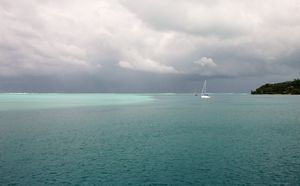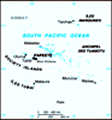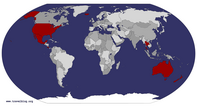Advertisement
Published: November 29th 2011

 Huahine
Huahine
I love this change in color, even on a cloudy day it is beautiful here.The clouds have broke and the sun is finding its way out to shine on us. After breakfast today we are going on tour of Huahine, which means vagina in Polynesian. The island vaguely has the shape, but it is probably named this due to the importance of the queens. Huahine is actually two islands, Huahine Nui and Huahine Iti, they are connected by a single bridge. Legend says that Hiro, a Polynesian god, rammed his canoe into the island to create this divide. Later the driver points out marks in the land from Hiro’s oar, and even his rocky phallus. The driver has the first mullet that I have seen since I got here, talk about absolute power. The seven of us climb in the back of a four wheel drive truck with benches fixed to each side of the bed and take off. There is a speaker secured to the truck, we listen to stories from the driver in both French and English as we make the circle around the island; everytime we pass anyone "honk, honk, honk, honk, honk... honk, honk" all the way around the island. There are plenty of great views, but there is not much
to Huahine. It is a very quiet fishing island. The island’s history is not so boring.
We stop at a couple of sights that over look the ocean or a bay, our guide uses a piece of PVC to knock a few mangoes from a tree and passes them to the women in the group. The place is packed with avocado trees, mango trees, banana trees, it is very easy to find something to eat here. After this short off road trip through the center of the island we stop in a small town to see the famous fresh water eels. These things are huge, and hideous. Long brown eels with striking blue eyes, and our guide is in the water with these four foot long water snake encouraging them to kiss him. It was all a little weird, but interesting to see. Loaded up back in the truck we head off to see large fish traps that the islanders have built. Stones placed in the water create channels in the river with a large opening but narrow to a couple of feet, at the end there is a larger “holding area.” The walk the river using
large scoop nets to catch the fish using these channels. The entire island has helped build them so anyone can come use them and take fish from the traps. He goes on to tell us what a boring life it is. They wake up, eat breakfast, harvest the fish, play cards, party, go to bed and do it all over again. The mood gets a little somber as he drives us to the most important marae, on the island. Maraes are the temple like structures of his people, there are 241 of them on Huahine. Once we reach the Marae, he parks the truck and walks around to tell us the story. He starts off, “my people were cannibals,“ and goes on to tell the story about the sacrifices to the gods. The royal family would choose the best and brightest from the island to use in sacrifice to the gods here at this marae. It was an honor to be chosen. They would sedate you, carry you to the top of the marae, then they would break your head open with a rock. The king would eat your brain, eyes and heart. The people would eat your flesh… raw,
and then bury your bones in the center of the marae. He asked us the question who ended this tradition. My guess was French government, and then the church when Christianity came to the island. To which his response was “No, my people killed them.” And, “no, my people killed them too. Who was very important in our culture?… The queens, the queens ended the sacrifices.” He went on to explain how a royal son was chosen for sacrifice, and after it was done the queen said no more. The last, documented, human sacrifice was made in 1906. Now for some stomach turning math. There are 241 maraes on this island. One to five human sacrifices per year were performed. This made my skin crawl, just thinking about this, sitting in front of him as he told this story, looking into his dark eyes. There was pride in the story, in the telling of his history. The whole thing made me a bit nauseous. (There is a recent story, four months, about a German couple in the Marquesas. A man and his son left the wife on the boat to go into town to secure some provisions, the two of
them never returned. All that was found was their teeth and bones. The speculation is that they were eaten as part of a not so ancient ceremony.)
After walking around this marae for a bit we were ushered back to the truck and off we went down the sand alongside the ocean before turning left down an unpaved road half covered in water from the recent rains. This part of the island was home to many farms, they grow cantaloupe, breadfruit, grapefruit and watermelon here mostly. There were also a few vanilla farms, but he said that the price has gone down so fewer people are growing it. Ralph and Margarette had a brief argument with him about the price of vanilla here versus back home until they realized they were wrong. They pay twice as much in Germany and the quality is probably half as good. The last stop before we went back to town was Maeva Archaeological Site, this area was the home of the royal family and now to many maraes.
Once we were all safely back on boat we had to navigate four hours back to Raiatea for the Polynesian
soiree. The sun was shining so I spent my time on the front of the catamaran soaking in the sun, feeling the wind in my face, and listening to the boat skip across the Pacific. Upon arrival we dropped anchor near a motu and went for a swim. More people got the courage to jump off the back of the boat, I took a picture of Stephane and Nancy as they jumped together. Mirko made it off, but Bernadette could not muster the courage. Wen showed off his front flip, but would not try a back one. I was finally able to land my back one and a half cleanly, which I was pretty proud of. We swam around for about 45 minutes before I headed inside to take a shower and get ready for the night.
I had seen the show the week before when I had stayed at Hawaiki Nui, but it was a little different, plus this time I was able to sit at a table and enjoy dinner and the show. Hinano, we found out around day three that her real name is Juliette, joined us, but Wen remained on the ship. The
couples drank wine, and Juliette and I had Hinanos, with dinner. There were three courses, all were very good, but the dessert was a fresh fruit and ginger custard that was absolutely amazing. When the show came to the point where the dancers came out to grab members of the audience Nancy, Juliette and I were all picked and went out to put on a show. The others sat back and took photos and video of us, really hope those don’t get circulated. When the show was finished we settled up our tabs, called the van to pick us up and then waited outside on the end of the dock the ten minutes that it took to arrive.
This morning I woke up before sunrise and watched it from the catamaran in the harbor. I was sad to have to leave boat. I had an amazing adventure on it. What I would give to be able to stay. Once the sun was about an hour into the morning sky I dropped down through my hatch to pack my things, and then sat down for a little breakfast. Once I had eaten something I decided to walk around
and have a look to see what I could find. There was not a whole lot to see close to the ship and I soon made my way back to the boat a little bit sad to be leaving. I tipped Wen and Juliette, not nearly enough for all that they did and the significant impact they had on my trip. They were very appreciative, Wen even gave me some vanilla beans from his own farm. The goodbye made my eyes well up a bit as we loaded our things onto the van. The Germans, the Canadians and I headed off to the airport.
I am sitting here in the Papeette airport waiting for my flight to Moorea; the Germans are on their way to The Marquesas, Stephane and Nancy are staying here in Papeete for the night, the Italians will take off home to Milano later today. Juliette has a thirteen day break to spend with her son in her own home, in her own bed, with her own car. Wen will spend time with his family as well. I will miss them all, I already do. Stephane and Juliette are on Facebook and by the
time you read this I have probably already added them. Like many of the people I meet on my travels I hope to see them again, and am sad because I know that I probably will not. I wish them all the best, and if they come to read this I hope they know that they impacted my life and I will never forget them.
Advertisement
Tot: 0.105s; Tpl: 0.013s; cc: 14; qc: 78; dbt: 0.0749s; 1; m:domysql w:travelblog (10.17.0.13); sld: 1;
; mem: 1.2mb





















